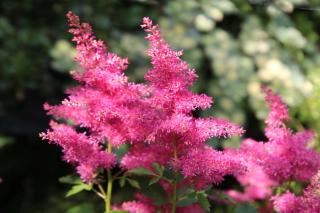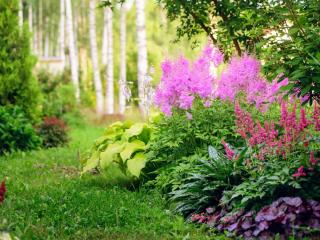

Astilbe is a dense, bushy perennial, notorious for its leafage and stunning flowers.
Key Astilbe facts:
Name: Astilbe
Family: Saxifragaceae
Type: flower, perennial
Height: 1-3 ft / 30-100 cm (variety)
Exposure: shade or part sun
Soil: heath soil – Flowering: April to May
Its elegant and ethereal inflorescence also dresses the garden in hues of white, pink, and even purple, in spring.
The season is of no importance, astilbe can be planted in spring or in fall, but what it needs is acidic soil such as heath soil.
Propagation through rhizome division in spring or in fall, ideally every 3 years.
The astilbe is the perfect plant to garnish your pot arrangements, containers and garden boxes. Since it is available in all hues ranging from pink to red, it truly embellishes arrangements with other flowers and keeps its beautiful foliage up to the first frost spells.
 Remove wilted flowers regularly (deadheading).
Remove wilted flowers regularly (deadheading).
Cut back the clump at the end of winter in order to promote sprouting of new leaves.
It is a good idea to water regularly in the year of planting and then again whenever the weather is hot and dry, because astilbe has an aversion to dry spells.
If in pots, a good counsel is to water regularly in summer to avoid having the plant desiccate.
It is native to Europe and temperate Asia, and astilbe belongs to the same family as heuchera and the tiny saxifrage.
 A very fashionable plant in the days of our grand-parents who used it to decorate their gardens, astilbe is now making a comeback thanks the appearance of new varieties boasting very ornamental leafage, aside from the ease of its care.
A very fashionable plant in the days of our grand-parents who used it to decorate their gardens, astilbe is now making a comeback thanks the appearance of new varieties boasting very ornamental leafage, aside from the ease of its care.
The blooming ranges from tender pink to deep red, and includes white too; this depends on the variety.
The growing is quite easy and doesn’t require any special care.
Its resilience makes it insensitive to disease, and it thus never requires any treatment.